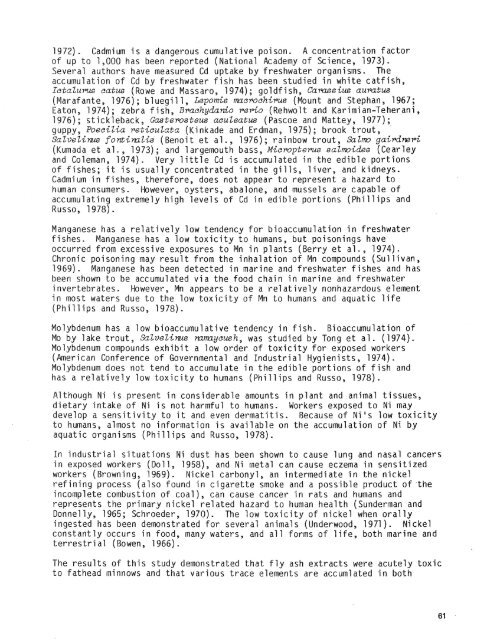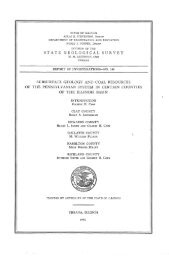Chemical and toxicological properties of coal fly ash - University of ...
Chemical and toxicological properties of coal fly ash - University of ...
Chemical and toxicological properties of coal fly ash - University of ...
- No tags were found...
You also want an ePaper? Increase the reach of your titles
YUMPU automatically turns print PDFs into web optimized ePapers that Google loves.
1972). Cadmium is a dangerous cumulative poison. A concentration factor<strong>of</strong> up to 1,000 has been reported (National Academy <strong>of</strong> Science, 1973).Several authors have measured Cd uptake by freshwater organisms. Theaccumulation <strong>of</strong> Cd by freshwater fish has been studied in white catfish,IctaZurms catus (Rowe <strong>and</strong> Massaro, 1974) ; goldfish, Camssius aumtus(Marafante, 1976); bluegill, Lepomis macrochirus (Mount <strong>and</strong> Stephan, 1967;Eaton, 1974) ; zebra fish, Brachydanio rerio (Rehwolt <strong>and</strong> Karimi an-Teherani ,76) ; stickleback, Gasterosteus aeuZeatus (Pascoe <strong>and</strong> Mattey, 1977) ;guppy, Poecilia reticulata (Ki nkade <strong>and</strong> Erdman, 1975) ; brook trout,SaZueZinu fontirrzlis (Benoi t et a1 . , 1976) ; rainbow trout, SaZm gairdneri(Kumada et a1 . , 1973) ; <strong>and</strong> 1 argemouth bass, Micropterus salmaides (Cearley<strong>and</strong> Coleman, 1974). Very little Cd is accumulated in the edible portions<strong>of</strong> fishes; it is usually concentrated in the gills, liver, <strong>and</strong> kidneys.Cadmium in fishes, therefore, does not appear to represent a hazard tohuman consumers. However, oysters, abalone, <strong>and</strong> mussels are capable <strong>of</strong>accumulating extremely high levels <strong>of</strong> Cd in edible portions (Phillips <strong>and</strong>Russo, 1978).Manganese has a relatively low tendency for bioaccumulation in freshwateranganese has a low toxicity to humans, but poisonings haveoccurred from excessive exposures to Mn in plants (Berry et a1 . , 1974).ronic poisoning may result from the inhalation <strong>of</strong> Mn compounds (Sullivan,69). Manganese has been detected in marine <strong>and</strong> freshwater fishes <strong>and</strong> haseen shown to be accumulated via the food chain in marine <strong>and</strong> freshwaterinvertebrates. However, Mn appears to be a relatively nonhazardous elementin most waters due to the low toxicity <strong>of</strong> Mn to humans <strong>and</strong> aquatic life(Phi 11 ips <strong>and</strong> Russo, 1978).Molybdenum has a low bioaccumulative tendency in fish. Bioaccumulation <strong>of</strong>Mo by lake trout, SaZveZims nzmycush, was studied by Tong et al. (1974).Molybdenum compounds exhibit a low order <strong>of</strong> toxicity for exposed workers(American Conference <strong>of</strong> Governmental <strong>and</strong> Industrial Hygienists, 1974).Molybdenum does not tend to accumulate in the edible portions <strong>of</strong> fish <strong>and</strong>has a relatively low toxicity to humans (Phillips <strong>and</strong> Russo, 1978).A1 though Ni is present in considerable amounts in plant <strong>and</strong> animal tissues,dietary intake <strong>of</strong> Ni is not harmful to humans. Workers exposed to Ni maydevelop a sensitivity to it <strong>and</strong> even dermatitis. Because <strong>of</strong> Nik low toxicityto humans, almost no information is available on the accumulation <strong>of</strong> Ni byaquatic organisms (Phillips <strong>and</strong> Russo, 1978).In industrial situations Ni dust has been shown to cause lung <strong>and</strong> nasal cancersin exposed workers (Do11,1958), <strong>and</strong> Ni metal can cause eczema i ti sensitizedworkers (Browning, 1969). Nickel carbonyl, an intermediate in the nickelrefining process (also found in cigarette smoke <strong>and</strong> a possible product <strong>of</strong> theincomplete combustion <strong>of</strong> <strong>coal</strong>), can cause cancer in rats <strong>and</strong> humans <strong>and</strong>represents the primary nickel related hazard to human health (Sunderman <strong>and</strong>Donnelly, 1965; Schroeder, 1970). The low toxicity <strong>of</strong> nickel when orallyingested has been demonstrated for several animals (Underwood, 1971). Nickelconstantly occurs in food, many waters, <strong>and</strong> all forms <strong>of</strong> life, both marine <strong>and</strong>terrestrial (Bowen, 1966).The results <strong>of</strong> this study demonstrated that <strong>fly</strong> <strong>ash</strong> extracts were acutely toxicto fathead minnows <strong>and</strong> that various trace elements are accumlated in both
















